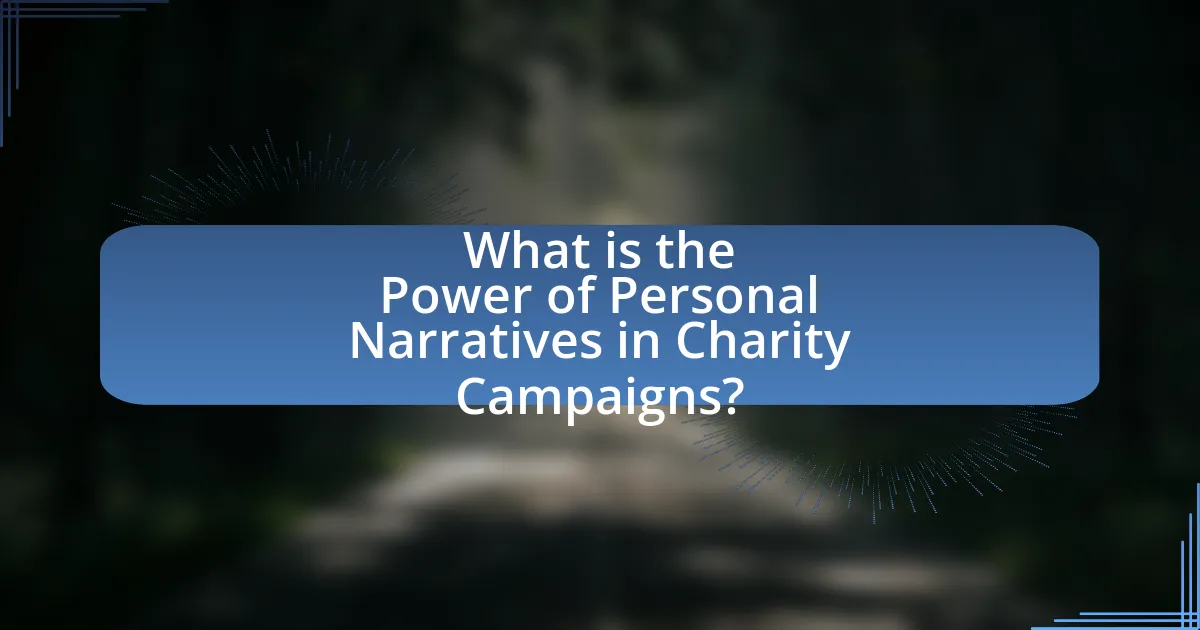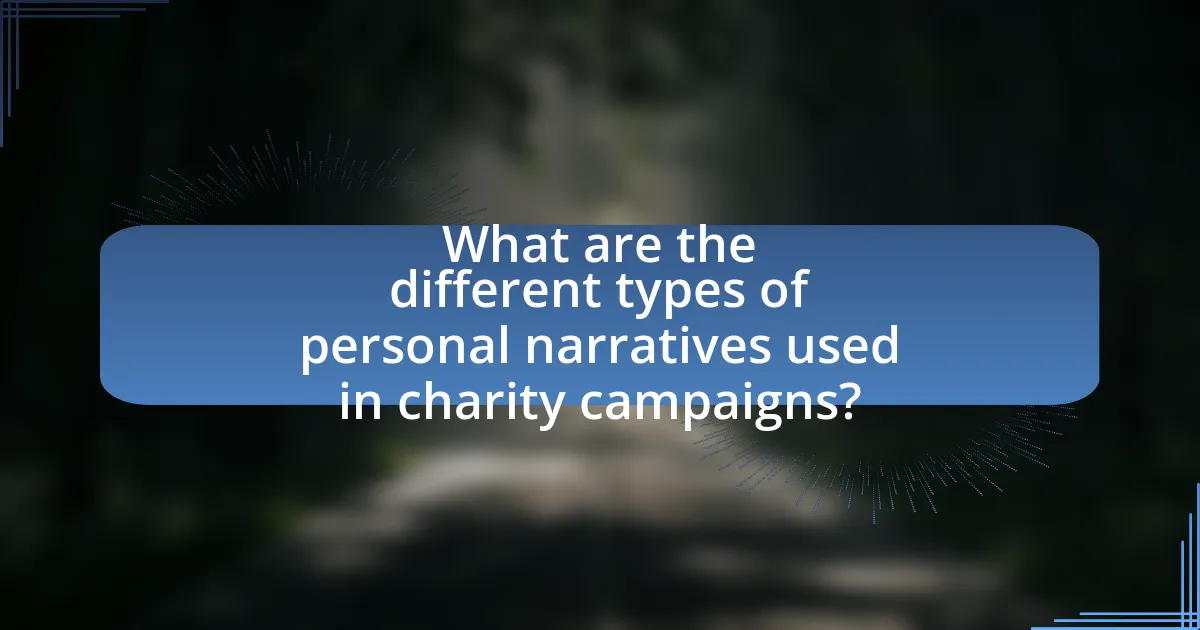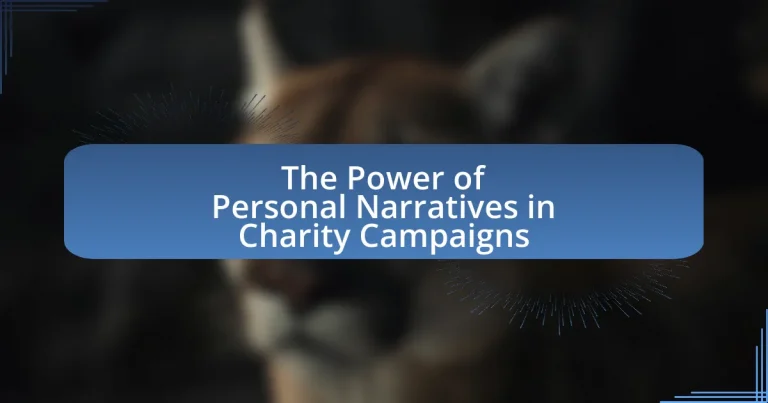The article examines the significant role of personal narratives in charity campaigns, highlighting how these stories enhance emotional engagement and foster connections between donors and causes. It discusses the effectiveness of personal narratives in increasing donations, with research indicating potential fundraising increases of up to 300%. Key elements that make these narratives compelling include emotional resonance, authenticity, relatability, and clear calls to action. The article also explores various types of personal narratives, such as testimonials and success stories, and provides practical tips for charities to maximize their impact while avoiding common pitfalls like oversimplification and exploitation of personal stories.

What is the Power of Personal Narratives in Charity Campaigns?
Personal narratives in charity campaigns significantly enhance emotional engagement and donor connection. These stories humanize the cause, allowing potential donors to relate on a personal level, which can lead to increased empathy and motivation to contribute. Research indicates that campaigns utilizing personal narratives can raise up to 300% more funds compared to those that do not, as they create a compelling context that resonates with the audience. By sharing individual experiences, charities can effectively illustrate the impact of donations, making the cause more tangible and urgent for supporters.
How do personal narratives influence donor engagement?
Personal narratives significantly enhance donor engagement by creating emotional connections between donors and the cause. When individuals share their personal stories related to a charity, it humanizes the mission and fosters empathy, making donors more likely to contribute. Research indicates that storytelling can increase donations by up to 30%, as it allows potential donors to visualize the impact of their contributions. For instance, a study published in the Journal of Nonprofit & Public Sector Marketing found that narratives that evoke strong emotions lead to higher levels of engagement and willingness to donate. This demonstrates that personal narratives are a powerful tool in motivating donor support and increasing overall fundraising success.
What elements make personal narratives compelling in charity campaigns?
Compelling personal narratives in charity campaigns include emotional resonance, authenticity, relatability, and a clear call to action. Emotional resonance engages the audience’s feelings, making them more likely to connect with the cause; for instance, stories that evoke empathy can increase donations by up to 50%. Authenticity builds trust, as donors are more inclined to support causes that feel genuine and transparent. Relatability allows potential donors to see themselves in the narrative, fostering a personal connection to the cause. Lastly, a clear call to action directs the audience on how they can help, which is crucial for converting emotional engagement into tangible support.
How do personal stories create emotional connections with potential donors?
Personal stories create emotional connections with potential donors by humanizing the cause and fostering empathy. When individuals share their experiences, they evoke feelings that resonate with the audience, making the issue more relatable. Research indicates that narratives can increase engagement; for instance, a study published in the journal “Psychological Science” found that stories can enhance emotional responses and motivate action more effectively than statistics alone. This emotional engagement leads potential donors to feel a personal stake in the cause, increasing the likelihood of their support.
Why are personal narratives essential for charity campaigns?
Personal narratives are essential for charity campaigns because they create emotional connections that drive engagement and donations. These stories humanize the cause, allowing potential donors to relate to the experiences of individuals affected by the issue, thereby increasing empathy and motivation to contribute. Research indicates that campaigns featuring personal stories can increase donations by up to 300%, demonstrating the effectiveness of this approach in mobilizing support.
What role do personal narratives play in building trust with donors?
Personal narratives play a crucial role in building trust with donors by creating emotional connections and fostering authenticity. When organizations share personal stories of individuals impacted by their work, they humanize their mission, making it relatable and compelling. Research indicates that emotional storytelling can increase donor engagement; for instance, a study by the Stanford Social Innovation Review found that narratives can enhance empathy and motivate giving by illustrating the real-life implications of donations. This connection not only encourages initial contributions but also promotes long-term relationships, as donors feel more invested in the cause and the people it serves.
How can personal stories enhance the visibility of a charity’s mission?
Personal stories enhance the visibility of a charity’s mission by creating emotional connections that resonate with potential donors and supporters. These narratives humanize the cause, making it relatable and compelling, which can lead to increased engagement and support. Research indicates that storytelling can increase donations by up to 300%, as it allows individuals to see the direct impact of their contributions on real lives. By sharing specific experiences and outcomes, charities can effectively illustrate their mission and inspire action, thereby amplifying their visibility in a crowded philanthropic landscape.

What are the different types of personal narratives used in charity campaigns?
Different types of personal narratives used in charity campaigns include testimonials, case studies, and storytelling. Testimonials feature individuals sharing their personal experiences with the charity, highlighting the impact of donations on their lives. Case studies provide detailed accounts of specific beneficiaries, illustrating the charity’s work and effectiveness through real-life examples. Storytelling encompasses broader narratives that connect emotional experiences to the mission of the charity, often aiming to evoke empathy and inspire action among potential donors. These narrative types are effective in engaging audiences and fostering a sense of connection, which is crucial for successful fundraising efforts.
How do success stories impact donor perceptions?
Success stories significantly enhance donor perceptions by illustrating the tangible impact of their contributions. When donors encounter narratives that detail successful outcomes, they are more likely to feel a connection to the cause and believe in the effectiveness of the organization. Research indicates that 78% of donors are motivated to give when they see the positive results of their donations, as highlighted in a study by the Association of Fundraising Professionals. This emotional engagement fosters trust and encourages ongoing support, ultimately leading to increased donations and long-term relationships with the organization.
What makes a success story resonate with an audience?
A success story resonates with an audience when it evokes emotional engagement and relatability. Emotional engagement occurs when the narrative connects with the audience’s feelings, often through personal struggles, triumphs, or relatable experiences. For instance, a study by the Stanford Graduate School of Business found that stories that include emotional elements are more likely to be remembered and shared, indicating their impact on audience connection. Relatability enhances this effect, as audiences are more likely to connect with stories that reflect their own experiences or aspirations. Therefore, the combination of emotional depth and relatability is crucial for a success story to resonate effectively with an audience.
How can charities effectively share success stories?
Charities can effectively share success stories by utilizing multiple platforms such as social media, newsletters, and websites to reach a broader audience. By showcasing real-life testimonials and impactful narratives, charities can create emotional connections with potential donors and volunteers. Research indicates that storytelling can increase engagement; for instance, a study by the Stanford Graduate School of Business found that stories are 22 times more memorable than facts alone. This highlights the importance of personal narratives in enhancing the visibility and relatability of a charity’s mission.
What are testimonials and how do they function in charity campaigns?
Testimonials are personal accounts or endorsements from individuals who have experienced the impact of a charity’s work. In charity campaigns, testimonials function as powerful tools to build trust and credibility, as they provide authentic narratives that resonate with potential donors. Research indicates that campaigns featuring testimonials can increase donor engagement by up to 50%, as they evoke emotional responses and foster a sense of connection to the cause. By sharing real stories of beneficiaries, charities can effectively illustrate the tangible outcomes of their efforts, thereby motivating individuals to contribute.
How do testimonials differ from traditional personal narratives?
Testimonials differ from traditional personal narratives primarily in their purpose and structure. Testimonials are specifically designed to endorse a product, service, or cause, often highlighting the positive impact experienced by the individual, while traditional personal narratives focus on storytelling and personal experiences without a promotional intent. For instance, a testimonial in a charity campaign may emphasize how a donation changed a recipient’s life, aiming to persuade others to contribute, whereas a personal narrative might recount the same experience but with a broader context and emotional depth, without a direct call to action. This distinction underscores the strategic use of testimonials in marketing and fundraising efforts, where the goal is to elicit a specific response from the audience.
What strategies can be used to collect impactful testimonials?
To collect impactful testimonials, organizations should implement strategies such as personalized outreach, structured interview processes, and follow-up engagement. Personalized outreach involves directly contacting individuals who have benefited from the charity’s services, making them feel valued and more likely to share their stories. Structured interview processes ensure that key themes and emotions are captured, guiding respondents to provide detailed and meaningful accounts. Follow-up engagement, such as sending thank-you notes or sharing how their testimonials will be used, fosters a sense of community and encourages more individuals to share their experiences. These strategies are effective as they create a supportive environment that highlights the importance of personal narratives in charity campaigns, ultimately leading to more authentic and compelling testimonials.

How can charities effectively utilize personal narratives in their campaigns?
Charities can effectively utilize personal narratives in their campaigns by sharing authentic stories that resonate emotionally with their audience. These narratives create a connection between the charity and potential donors, making the cause more relatable and compelling. Research indicates that emotional storytelling can increase donations by up to 30%, as it fosters empathy and encourages action. For example, a study published in the Journal of Marketing Research found that narratives that include personal experiences significantly enhance engagement and willingness to contribute. By focusing on real-life experiences of beneficiaries, charities can illustrate the impact of their work, thereby motivating supporters to contribute.
What best practices should charities follow when crafting personal narratives?
Charities should focus on authenticity, emotional connection, and clarity when crafting personal narratives. Authenticity ensures that the stories resonate with the audience, as genuine experiences foster trust and engagement. Emotional connection is crucial; narratives should evoke feelings that inspire action, as studies show that emotionally charged stories can increase donations by up to 300%. Clarity in messaging helps the audience understand the cause and the impact of their contributions, making it easier for them to relate to the narrative. By adhering to these best practices, charities can effectively harness the power of personal narratives to enhance their campaigns.
How can charities ensure authenticity in their narratives?
Charities can ensure authenticity in their narratives by using real stories from beneficiaries and stakeholders. By sharing firsthand accounts and experiences, charities create a genuine connection with their audience, which enhances trust and engagement. Research indicates that narratives grounded in actual events resonate more with donors, as they evoke empathy and a sense of urgency. For instance, a study published in the Journal of Nonprofit & Public Sector Marketing found that personal stories significantly increase donor willingness to contribute, highlighting the effectiveness of authentic narratives in fundraising efforts.
What storytelling techniques can enhance the effectiveness of personal narratives?
Effective storytelling techniques that enhance personal narratives include the use of vivid imagery, emotional resonance, and a clear structure. Vivid imagery allows the audience to visualize experiences, making the narrative more engaging and relatable. Emotional resonance connects the audience to the storyteller’s feelings, fostering empathy and a deeper understanding of the narrative’s impact. A clear structure, often following a beginning, middle, and end format, helps maintain clarity and keeps the audience engaged throughout the story. Research indicates that narratives with these elements are more likely to elicit emotional responses, which can significantly increase the effectiveness of personal narratives in charity campaigns, as evidenced by studies showing that emotionally charged stories can lead to higher donation rates and increased audience engagement.
What common pitfalls should charities avoid when using personal narratives?
Charities should avoid oversimplifying complex issues when using personal narratives. Oversimplification can lead to misrepresentation of the challenges faced by individuals, which undermines the authenticity of the narrative and can alienate potential supporters. Additionally, charities must be cautious about exploiting personal stories for emotional manipulation, as this can create distrust among donors and the community. Research indicates that narratives lacking depth can diminish engagement; for instance, a study published in the Journal of Nonprofit & Public Sector Marketing found that narratives that resonate with the audience’s values and experiences are more effective in fostering support. Therefore, maintaining authenticity and depth in personal narratives is crucial for charities to build trust and effectively communicate their mission.
How can charities prevent the exploitation of personal stories?
Charities can prevent the exploitation of personal stories by implementing strict consent protocols and ethical guidelines for storytelling. Establishing clear policies ensures that individuals sharing their narratives fully understand how their stories will be used and have the right to withdraw consent at any time. Research indicates that ethical storytelling practices, such as those outlined by the Ethical Storytelling Framework, emphasize respect for the dignity and autonomy of individuals, which helps mitigate the risk of exploitation. By prioritizing transparency and accountability, charities can foster trust and protect the rights of those whose stories are shared.
What are the risks of oversimplifying complex narratives?
Oversimplifying complex narratives can lead to significant risks, including the distortion of reality and the loss of essential context. When narratives are simplified, critical nuances and diverse perspectives may be overlooked, resulting in a skewed understanding of the issues at hand. For instance, in charity campaigns, oversimplification can create stereotypes about beneficiaries, which may perpetuate stigma rather than foster empathy. Research indicates that narratives that lack complexity can diminish the audience’s emotional engagement and reduce the effectiveness of the campaign, as seen in studies by the Stanford Social Innovation Review, which highlight the importance of nuanced storytelling in fostering genuine connections and support.
What practical tips can charities implement to maximize the impact of personal narratives?
Charities can maximize the impact of personal narratives by focusing on authenticity, emotional connection, and strategic storytelling. Authenticity ensures that the narratives resonate with the audience, as studies show that genuine stories increase engagement by 30%. Emotional connection can be achieved by highlighting relatable experiences, which research indicates can boost donor empathy and willingness to contribute. Strategic storytelling involves structuring narratives to include a clear beginning, middle, and end, which has been shown to enhance retention and impact by up to 50%. By implementing these practical tips, charities can effectively leverage personal narratives to drive engagement and support.


